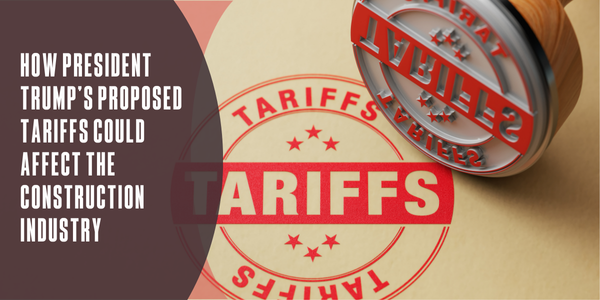UP TO THE MINUTE
How President Trump’s proposed tariffs could affect the construction industry
February 11, 2025 at 10:00 a.m.By Trent Cotney, Adams and Reese.
While the full impact of the tariffs remains to be seen, proactive measures can help mitigate risks and ensure continued operational resilience.
If you have read the news lately, you know that President Trump plans to reintroduce tariffs on goods imported from key trading partners. These measures, aimed at addressing economic and security concerns, have sparked widespread uncertainty within the construction industry. If implemented, the tariffs could lead to price increases for critical construction materials and disrupt supply chains, affecting project costs and timelines.
The president’s initial plans included 25 percent tariffs for goods from Canada and Mexico and 10 percent for goods from China. Currently, the tariffs impacting Canada and Mexico are on hold until at least March 2025. Meanwhile, Trump announced on February 7 that low-value shipments from China would be exempt. However, he stated his intent to impose tariffs on more countries in the weeks ahead.
Such tariffs involving multiple countries could lead to price increases for critical construction materials and disrupt supply chains, affecting project costs and timelines.
Background on tariffs
During his first administration, Trump imposed Section 232 tariffs on imports of aluminum and steel (10 and 25 percent, respectively), citing national security threats. Additionally, Section 301 tariffs targeted Chinese goods worth approximately $370 billion in response to alleged unfair trade practices. These tariffs led to significant price hikes for essential materials, including metals, coatings and electrical components.
The potential 2025 tariffs could have an even broader impact. Experts predict steep price increases for construction-related imports from China, including plumbing components, HVAC parts and other lower-cost commodities. Furthermore, across-the-board tariffs of 25 percent on goods from Canada and Mexico are under consideration, reminiscent of measures implemented in 2018 that strained economic relations and disrupted material supplies.
Implications for the construction industry
Material price increases
Tariffs on imported steel, aluminum and other construction materials will likely lead to increased costs for builders and developers. Higher prices for essential goods could make large-scale infrastructure and commercial projects more expensive and potentially unviable. Past studies have shown that the costs associated with tariffs are often passed down to consumers, which may result in higher home prices and commercial rent rates.
Supply chain disruptions
Canada, Mexico and China are critical suppliers of construction materials to the United States. Disruptions in these supply chains could cause delays and limit the availability of essential components. For example, the Canadian mineral processing sector and Mexico’s auto and electrical equipment industries are particularly exposed to the effects of the tariffs. Such disruptions may necessitate finding alternative suppliers, potentially increasing lead times and logistical challenges.
Inflationary pressures
Economists warn that the proposed tariffs could contribute to inflationary pressures, both in the construction industry and the broader economy. Higher costs for materials and labor could ripple through the supply chain, impacting various sectors reliant on construction activity, including real estate and manufacturing.
Strategies for mitigating impact
In response to these challenges, construction companies are exploring several strategies to mitigate the impact of potential tariffs:
- Advance purchasing: Some companies are purchasing materials in advance and in bulk to lock in lower prices before tariffs take effect.
- Diversified sourcing: Firms are seeking alternative suppliers and emphasizing the use of domestically sourced materials, which are less susceptible to tariff-related price fluctuations.
- Contract reviews: Companies are reviewing existing purchase orders and contracts to ensure they contain provisions addressing tariff-related cost increases. Where necessary, they are negotiating terms to account for pricing changes.
- Force majeure clauses: Some businesses are reviewing contractual clauses related to changes in law and force majeure to determine whether cost increases due to tariffs can be passed along the supply chain.
- Price acceleration provisions: These provisions allow for an adjustment of the contract in the event material line items exceed a certain percentage after contract execution.
Potential legal and trade implications
The imposition of tariffs by executive order raises legal questions, as the U.S. Constitution grants Congress the authority to regulate trade. While the Republican-controlled Congress may support the administration’s measures, consensus is not guaranteed. Moreover, the proposed tariffs could violate U.S. commitments under international trade agreements, including the United States-Mexico-Canada Agreement (USMCA) and the World Trade Organization (WTO) framework.
If the tariffs on materials from Mexico and Canada are implemented, retaliatory measures are possible. Canadian officials have hinted at targeting U.S. goods such as orange juice, whiskey and peanut butter, while Mexico has signaled readiness to impose its own tariffs. These responses could further exacerbate trade tensions and economic uncertainty.
Looking ahead
The construction industry must remain vigilant as the situation unfolds. Companies are advised to stay current on policy changes and adapt their processes accordingly. While the full impact of the tariffs remains to be seen, proactive measures can help mitigate risks and ensure continued operational resilience.
Trent Cotney is a partner and Construction Practice Group Leader at the law firm of Adams and Reese LLP and NRCA General Counsel. See his full bio here.
The information contained in this article is for general educational information only. This information does not constitute legal advice, is not intended to constitute legal advice, nor should it be relied upon as legal advice for your specific factual pattern or situation.



















Comments
Leave a Reply
Have an account? Login to leave a comment!
Sign In